List of birds of Guatemala
This is a list of the bird species recorded in Guatemala. The avifauna of Guatemala includes a total of 735 species, of which 1 is endemic, 2 have been introduced by humans, and 23 are rare or accidental. 10 species are globally threatened.
This list's taxonomic treatment (designation and sequence of orders, families, and species) and nomenclature (common and scientific names) follow the conventions of Clements's 5th edition. The family accounts at the beginning of each heading reflects this taxonomy, as do the species counts found in each family account. Introduced and accidental species are included in the total counts for Guatemala.
The following tags have been used to highlight certain relevant categories. The commonly occurring, native, species do not fall into any of these categories.
- (A) Accidental A species that rarely or accidentally occurs in Guatemala.
- (E) Endemic A species endemic to Guatemala.
- (I) Introduced A species introduced to Guatemala as a consequence, direct or indirect, of human actions.
Tinamous
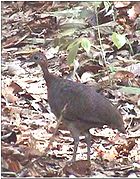
Order: Tinamiformes. Family: Tinamidae
The tinamous are one of the most ancient groups of bird. Although they look similar to other ground-dwelling birds like quail and grouse, they have no close relatives and are classified as a single family Tinamidae within their own order, the Tinamiformes. They are distantly related to the ratites (order Struthioniformes), that includes the rheas, emu, and kiwi. There are 47 species worldwide and 4 species which occur in Guatemala.
- Great Tinamou Tinamus major
- Little Tinamou Crypturellus soui
- Slaty-breasted Tinamou Crypturellus boucardi
- Thicket Tinamou Crypturellus cinnamomeus
Grebes
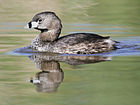
Order: Podicipediformes. Family: Podicipedidae
Grebes are small to medium-large sized freshwater diving birds. They have lobed toes, and are excellent swimmers and divers. However, they have their feet placed far back on the body, making them quite ungainly on land. There are 20 species worldwide and 3 species which occur in Guatemala.
- Least Grebe Tachybaptus dominicus
- Pied-billed Grebe Podilymbus podiceps
- Eared Grebe Podiceps nigricollis
Shearwaters and petrels
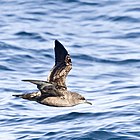
Order: Procellariiformes. Family: Procellariidae
The procellariids are the main group of medium-sized 'true petrels', characterised by united nostrils with a medium septum, and a long outer functional primary. There are 75 species worldwide and 6 species which occur in Guatemala.
- Parkinson's Petrel Procellaria parkinsoni
- Pink-footed Shearwater Puffinus creatopus
- Wedge-tailed Shearwater Puffinus pacificus
- Sooty Shearwater Puffinus griseus
- Christmas Shearwater Puffinus nativitatis
- Audubon's Shearwater Puffinus lherminieri
Storm-Petrels
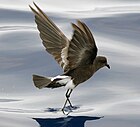
Order: Procellariiformes. Family: Hydrobatidae
The storm-petrels are relatives of the petrels, and are the smallest of seabirds. They feed on planktonic crustaceans and small fish picked from the surface, typically while hovering. The flight is fluttering and sometimes bat-like. There are 21 species worldwide and 6 species which occur in Guatemala.
- Wilson's Storm-Petrel Oceanites oceanicus (A)
- Least Storm-Petrel Oceanodroma microsoma
- Wedge-rumped Storm-Petrel Oceanodroma tethys
- Leach's Storm-Petrel Oceanodroma leucorhoa
- Markham's Storm-Petrel Oceanodroma markhami (A)
- Black Storm-Petrel Oceanodroma melania
Tropicbirds

Order: Pelecaniformes. Family: Phaethontidae
Tropicbirds are slender white birds of tropical oceans, with exceptionally long central tail feathers. Their heads and long wings have black markings. There are 3 species worldwide and 2 species which occur in Guatemala.
- Red-billed Tropicbird Phaethon aethereus
- White-tailed Tropicbird Phaethon lepturus (A)
Pelicans

Order: Pelecaniformes. Family: Pelecanidae
Pelicans are large water birds with a distinctive pouch under the beak. As with other members of the order Pelecaniformes, they have webbed feet with four toes. There are 8 species worldwide and 2 species which occur in Guatemala.
- American White Pelican Pelecanus erythrorhynchos
- Brown Pelican Pelecanus occidentalis
Boobies and gannets
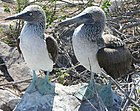
Order: Pelecaniformes. Family: Sulidae
The sulids comprise the gannets and boobies. Both groups comprise medium-to-large coastal seabirds that plunge-dive for fish. There are 9 species worldwide and 4 species which occur in Guatemala.
- Blue-footed Booby Sula nebouxii
- Masked Booby Sula dactylatra
- Red-footed Booby Sula sula
- Brown Booby Sula leucogaster
Cormorants

Order: Pelecaniformes. Family: Phalacrocoracidae
The Phalacrocoracidae is a family of medium-to-large coastal, fish-eating seabirds that includes cormorants and shags. Plumage colouration varies with the majority having mainly dark plumage, some species being black and white, and a few being colourful. There are 38 species worldwide and 2 species which occur in Guatemala.
- Double-crested Cormorant Phalacrocorax auritus
- Neotropic Cormorant Phalacrocorax brasilianus
Darters

Order: Pelecaniformes. Family: Anhingidae
Darters are frequently referred to as "snake-birds" because of their long thin neck, which gives a snake-like appearance when they swim with their bodies submerged. The males have black and dark brown plumage, an erectile crest on the nape and a larger bill than the female. The females have a much paler plumage especially on the neck and underparts. The darters have completely webbed feet, and their legs are short and set far back on the body. Their plumage is somewhat permeable, like that of cormorants, and they spread their wings to dry after diving. There are 4 species worldwide and 1 species which occurs in Guatemala.
- Anhinga Anhinga anhinga
Frigatebirds

Order: Pelecaniformes. Family: Fregatidae
Frigatebirds are large seabirds usually found over tropical oceans. They are large, black and white or completely black, with long wings and deeply-forked tails. The males have inflatable coloured throat pouches. They do not swim or walk, and cannot take off from a flat surface. Having the largest wingspan to body weight ratio of any bird, they are essentially aerial, able to stay aloft for more than a week. There are 5 species worldwide and 1 species which occurs in Guatemala.
- Magnificent Frigatebird Fregata magnificens
Bitterns, herons and egrets


Order: Ciconiiformes. Family: Ardeidae
The family Ardeidae contains the bitterns, herons and egrets. Herons and egrets are medium to large sized wading birds with long necks and legs. Bitterns tend to be shorter necked and more wary. Unlike other long-necked birds suck as storks, ibises and spoonbills, members of Ardeidae fly with their necks retracted. There are 61 species worldwide and 16 species which occur in Guatemala.
- Great Blue Heron Ardea herodias
- Great Egret Ardea alba
- Reddish Egret Egretta rufescens
- Tricolored Heron Egretta tricolor
- Little Blue Heron Egretta caerulea
- Snowy Egret Egretta thula
- Cattle Egret Bubulcus ibis
- Green Heron Butorides virescens
- Agami Heron Agamia agami
- Black-crowned Night-Heron Nycticorax nycticorax
- Yellow-crowned Night-Heron Nyctanassa violacea
- Boat-billed Heron Cochlearius cochlearius
- Bare-throated Tiger-Heron Tigrisoma mexicanum
- Least Bittern Ixobrychus exilis
- Pinnated Bittern Botaurus pinnatus
- American Bittern Botaurus lentiginosus (A)
Storks

Order: Ciconiiformes. Family: Ciconiidae
Storks are large, long-legged, long-necked, wading birds with long, stout bills. Storks are mute; bill-clattering is an important mode of stork communication at the nest. Their nests can be large and may be reused for many years. Many species are migratory. There are 19 species worldwide and 2 species which occur in Guatemala.
- Wood Stork Mycteria americana
- Jabiru Jabiru mycteria
Ibises and spoonbills

Order: Ciconiiformes. Family: Threskiornithidae
The Threskiornithidae is a family of large terrestrial and wading birds which includes the ibises and spoonbills. They have long, broad wings with 11 primary and about 20 secondary feathers. They are strong fliers and despite their size and weight, very capable soarers. There are 36 species worldwide and 3 species which occur in Guatemala.
- White Ibis Eudocimus albus
- White-faced Ibis Plegadis chihi
- Roseate Spoonbill Platalea ajaja
Ducks, geese and swans



Order: Anseriformes. Family: Anatidae
The family Anatidae includes the ducks and most duck-like waterfowl, such as geese and swans. These are birds that are modified for an aquatic existence with webbed feet, flattened bills and feathers that are excellent at shedding water due to an oily coating. There are 131 species worldwide and 16 species which occur in Guatemala.
- Fulvous Whistling-Duck Dendrocygna bicolor (A)
- Black-bellied Whistling-Duck Dendrocygna autumnalis
- Muscovy Duck Cairina moschata
- American Wigeon Anas americana
- Green-winged Teal Anas carolinensis
- Mallard Anas platyrhynchos (A)
- Northern Pintail Anas acuta
- Blue-winged Teal Anas discors
- Cinnamon Teal Anas cyanoptera
- Northern Shoveler Anas clypeata
- Canvasback Aythya valisineria (A)
- Redhead Aythya americana
- Ring-necked Duck Aythya collaris
- Lesser Scaup Aythya affinis
- Masked Duck Nomonyx dominica
- Ruddy Duck Oxyura jamaicensis
New World vultures

Order: Falconiformes. Family: Cathartidae
The New World vultures are not closely related to Old World vultures, but superficially resemble them because of convergent evolution. Like the Old World vultures, they are scavengers. However, unlike Old World vultures, which find carcasses by sight, New World vultures have a good sense of smell with which they locate carrion. There are 7 species worldwide, all of which are found only in the Americas, and 4 species which occur in Guatemala.
- Black Vulture Coragyps atratus
- Turkey Vulture Cathartes aura
- Lesser Yellow-headed Vulture Cathartes burrovianus
- King Vulture Sarcoramphus papa
Osprey

Order: Falconiformes. Family: Pandionidae
The Pandionidae family contains only one species, the Osprey. The Osprey is a medium large raptor which is a specialist fish-eater with a worldwide distribution.
- Osprey Pandion haliaetus
Hawks, kites and eagles
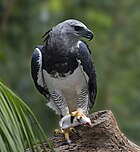
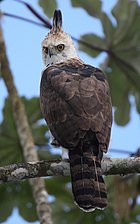


Order: Falconiformes. Family: Accipitridae
Accipitridae is a family of birds of prey and include hawks, eagles, kites, harriers and Old World vultures. These birds have powerful hooked beaks for tearing flesh from their prey, strong legs, powerful talons, and keen eyesight. There are 233 species worldwide and 33 species which occur in Guatemala.
- Gray-headed Kite Leptodon cayanensis
- Hook-billed Kite Chondrohierax uncinatus
- Swallow-tailed Kite Elanoides forficatus
- White-tailed Kite Elanus leucurus
- Snail Kite Rostrhamus sociabilis
- Double-toothed Kite Harpagus bidentatus
- Mississippi Kite Ictinia mississippiensis
- Plumbeous Kite Ictinia plumbea
- Northern Harrier Circus cyaneus
- Sharp-shinned Hawk Accipiter striatus
- Cooper's Hawk Accipiter cooperii
- Bicolored Hawk Accipiter bicolor
- Crane Hawk Geranospiza caerulescens
- White Hawk Leucopternis albicollis
- Common Black-Hawk Buteogallus anthracinus
- Great Black-Hawk Buteogallus urubitinga
- Harris's Hawk Parabuteo unicinctus
- Black-collared Hawk Busarellus nigricollis
- Solitary Eagle Harpyhaliaetus solitarius
- Gray Hawk Asturina nitida
- Roadside Hawk Buteo magnirostris
- Broad-winged Hawk Buteo platypterus
- Short-tailed Hawk Buteo brachyurus
- Swainson's Hawk Buteo swainsoni
- White-tailed Hawk Buteo albicaudatus
- Zone-tailed Hawk Buteo albonotatus
- Red-tailed Hawk Buteo jamaicensis
- Crested Eagle Morphnus guianensis
- Harpy Eagle Harpia harpyja
- Black-and-white Hawk-Eagle Spizastur melanoleucus
- Black Hawk-Eagle Spizaetus tyrannus
- Ornate Hawk-Eagle Spizaetus ornatus
Caracaras and falcons


Order: Falconiformes. Family: Falconidae
Falconidae is a family of diurnal birds of prey. They differ from hawks, eagles, and kites in that they kill with their beaks instead of their feet. There are 62 species worldwide and 11 species which occur in Guatemala.
- Red-throated Caracara Ibycter americanus
- Northern Caracara Caracara cheriway
- Laughing Falcon Herpetotheres cachinnans
- Barred Forest-Falcon Micrastur ruficollis
- Collared Forest-Falcon Micrastur semitorquatus
- American Kestrel Falco sparverius
- Aplomado Falcon Falco femoralis (A)
- Merlin Falco columbarius
- Bat Falcon Falco rufigularis
- Orange-breasted Falcon Falco deiroleucus
- Peregrine Falcon Falco peregrinus
Guans, Chachalacas and allies

Order: Galliformes. Family: Cracidae
The Cracidae are large birds, similar in general appearance to turkeys. The guans and curassows live in trees, but the smaller chachalacas are found in more open scrubby habitats. They are generally dull-plumaged, but the curassows and some guans have colourful facial ornaments. There are 50 species worldwide and 6 species which occur in Guatemala.
- Plain Chachalaca Ortalis vetula
- White-bellied Chachalaca Ortalis leucogastra
- Crested Guan Penelope purpurascens
- Highland Guan Penelopina nigra
- Horned Guan Oreophasis derbianus
- Great Curassow Crax rubra
Turkeys

Order: Galliformes. Family: Meleagrididae
Turkeys are similar to large pheasants but have a distinctive fleshy wattle that hangs from the beak, called a snood. The are two species, both native to the Americas, and1 species which occurs in Guatemala.
- Ocellated Turkey Meleagris ocellata
New World quails

Order: Galliformes. Family: Odontophoridae
The New World quails are small, plump terrestrial birds only distantly related to the quails of the Old World, but named for their similar appearance and habits. There are 32 species worldwide, all found only in the Americas, and 7 species which occur in Guatemala.
- Buffy-crowned Wood-Partridge Dendrortyx leucophrys
- Northern Bobwhite Colinus virginianus
- Black-throated Bobwhite Colinus nigrogularis
- Crested Bobwhite Colinus cristatus
- Spotted Wood-Quail Odontophorus guttatus
- Singing Quail Dactylortyx thoracicus
- Ocellated Quail Cyrtonyx ocellatus
Limpkins
Order: Gruiformes. Family: Aramidae
The Limpkin resembles a large rail. It has drab brown plumage and a greyer head and neck.
- Limpkin Aramus guarauna
Rails, crakes, gallinules, and coots


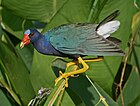
Order: Gruiformes. Family: Rallidae
Rallidae is a large family of small to medium-sized birds which includes the rails, crakes, coots, and gallinules. Typically they inhabit dense vegetation in damp environments near lakes, swamps, or rivers. In general they are shy and secretive birds, difficult to observe. Most species have strong legs, and have long toes which are well adapted to soft, uneven surfaces. They tend to have short, rounded wings and be weak fliers. There are 143 species worldwide and 13 species which occur in Guatemala.
- Ruddy Crake Laterallus ruber
- Gray-breasted Crake Laterallus exilis
- Black Rail Laterallus jamaicensis (A)
- Virginia Rail Rallus limicola
- Rufous-necked Wood-Rail Aramides axillaris
- Gray-necked Wood-Rail Aramides cajanea
- Uniform Crake Amaurolimnas concolor
- Sora Porzana carolina
- Yellow-breasted Crake Porzana flaviventer
- Spotted Rail Pardirallus maculatus
- Purple Gallinule Porphyrio martinica
- Common Moorhen Gallinula chloropus
- American Coot Fulica americana
Sungrebe and Finfoots

Order: Gruiformes. Family: Heliornithidae
The Heliornithidae are small family of tropical birds with webbed lobes on their feet similar to those of grebes and coots. There are 3 species worldwide and 1 species which occurs in Guatemala.
- Sungrebe Heliornis fulica
Sunbittern

Order: Gruiformes. Family: Eurypygidae
The Sunbittern is a bittern-like bird of tropical regions of the Americas, and the sole member of the family Eurypygidae (sometimes spelled Eurypigidae) and genus Eurypyga.
- Sunbittern Eurypyga helias
Jacanas

Order: Charadriiformes. Family: Jacanidae
The jacanas are a group of tropical waders in the family Jacanidae. They are found worldwide in the Tropics. They are identifiable by their huge feet and claws which enable them to walk on floating vegetation in the shallow lakes that are their preferred habitat. There 8 species worldwide and1 species which occurs in Guatemala.
- Northern Jacana Jacana spinosa
Oystercatchers

Order: Charadriiformes. Family: Haematopodidae
The oystercatchers are large and noisy plover-like birds, with strong bills used for smashing or prising open molluscs. There are 11 species worldwide and1 species which occurs in Guatemala.
- American Oystercatcher Haematopus palliatus
Avocets and stilts

Order: Charadriiformes. Family: Recurvirostridae
Recurvirostridae is a family of large wading birds, which includes the avocets and the stilts. The avocets have long legs and long up-curved bills. The stilts have extremely long legs and long, thin, straight bills. There are 9 species worldwide and 2 species which occur in Guatemala.
- Black-necked Stilt Himantopus mexicanus
- American Avocet Recurvirostra americana (A)
Thick-knees

Order: Charadriiformes. Family: Burhinidae
The thick-knees are a group of largely tropical waders in the family Burhinidae. They are found worldwide within the tropical zone, with some species also breeding in temperate Europe and Australia. They are medium to large waders with strong black or yellow black bills, large yellow eyes and cryptic plumage. Despite being classed as waders, most species have a preference for arid or semi-arid habitats. There are 9 species worldwide and 1 species which occurs in Guatemala.
- Double-striped Thick-knee Burhinus bistriatus
This is a largely nocturnal and crepuscular species of arid grassland, savanna, and other dry, open habitats. The Double-striped Thick-knee is a medium-large wader with a strong black and yellow bill, large yellow eyes, which give it a reptilian appearance, and cryptic plumage. It has finely streaked grey-brown upperparts, and a paler brown neck and breast merging into the white belly. The head has a strong white supercilium bordered above by a black stripe. There are four subspecies, differing in size and plumage tone, but individual variation makes identification of races difficult.
Plovers and lapwings
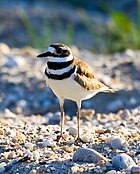
Order: Charadriiformes. Family: Charadriidae
The family Charadriidae includes the plovers, dotterels, and lapwings. They are small to medium-sized birds with compact bodies, short, thick necks and long, usually pointed, wings. They are found in open country worldwide, mostly in habitats near water, although there are some exceptions. There are 66 species worldwide and 7 species which occur in Guatemala.
- American Golden-Plover Pluvialis dominica
- Black-bellied Plover Pluvialis squatarola
- Semipalmated Plover Charadrius semipalmatus
- Wilson's Plover Charadrius wilsonia
- Killdeer Charadrius vociferus
- Snowy Plover Charadrius alexandrinus
- Collared Plover Charadrius collaris
Sandpipers and allies

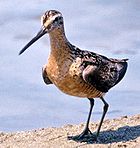

Order: Charadriiformes. Family: Scolopacidae
The Scolopacidae are a large diverse family of small to medium sized shorebirds including the sandpipers, curlews, godwits, shanks, tattlers, woodcocks, snipes, dowitchers and phalaropes. The majority of species eat small invertebrates picked out of the mud or soil. Variation in length of legs and bills enable different species to feed in the same habitat, particularly on the coast, without direct competition for food. There are 89 species worldwide and 31 species which occur in Guatemala.
- Wilson's Snipe Gallinago delicata
- Short-billed Dowitcher Limnodromus griseus
- Long-billed Dowitcher Limnodromus scolopaceus
- Hudsonian Godwit Limosa haemastica
- Marbled Godwit Limosa fedoa
- Eskimo Curlew Numenius borealis (A)
- Whimbrel Numenius phaeopus
- Long-billed Curlew Numenius americanus
- Upland Sandpiper Bartramia longicauda
- Greater Yellowlegs Tringa melanoleuca
- Lesser Yellowlegs Tringa flavipes
- Solitary Sandpiper Tringa solitaria
- Spotted Sandpiper Actitis macularia
- Wandering Tattler Heterosceles incanus
- Willet Catoptrophorus semipalmatus
- Ruddy Turnstone Arenaria interpres
- Surfbird Aphriza virgata
- Red Knot Calidris canutus
- Sanderling Calidris alba
- Semipalmated Sandpiper Calidris pusilla
- Western Sandpiper Calidris mauri
- Least Sandpiper Calidris minutilla
- White-rumped Sandpiper Calidris fuscicollis
- Baird's Sandpiper Calidris bairdii
- Pectoral Sandpiper Calidris melanotos
- Dunlin Calidris alpina
- Stilt Sandpiper Calidris himantopus
- Buff-breasted Sandpiper Tryngites subruficollis
- Ruff Philomachus pugnax (A)
- Wilson's Phalarope Phalaropus tricolor
- Red-necked Phalarope Phalaropus lobatus (A)
Skuas and jaegers

Order: Charadriiformes. Family: Stercorariidae
The family Stercorariidae are, in general, medium to large birds, typically with grey or brown plumage, often with white markings on the wings. They nest on the ground in temperate and arctic regions and are long-distance migrants. There are 7 species worldwide and 3 species which occur in Guatemala.
- Pomarine Jaeger Stercorarius pomarinus
- Parasitic Jaeger Stercorarius parasiticus
- Long-tailed Jaeger Stercorarius longicaudus
Gulls


Order: Charadriiformes. Family: Laridae
Laridae is a family of medium to large birds seabirds and includes gulls and kittiwakes. They are typically grey or white, often with black markings on the head or wings. They have stout, longish bills and webbed feet. There are 55 species worldwide and 7 species which occur in Guatemala.
- Heermann's Gull Larus heermanni
- Ring-billed Gull Larus delawarensis
- American Herring Gull Larus smithsonianus
- Bonaparte's Gull Larus philadelphia
- Laughing Gull Larus atricilla
- Franklin's Gull Larus pipixcan
- Sabine's Gull Xema sabini
Terns


Order: Charadriiformes. Family: Sternidae
Terns are a group of generally general medium to large seabirds typically with grey or white plumage, often with black markings on the head. Most terns hunt fish by diving but some pick insects off the surface of fresh water. Terns are generally long-lived birds, with several species now known to live in excess of 25 to 30 years. There are 44 species worldwide and 11 species which occur in Guatemala.
- Gull-billed Tern Sterna nilotica
- Caspian Tern Sterna caspia
- Elegant Tern Sterna elegans
- Sandwich Tern Sterna sandvicensis
- Royal Tern Sterna maxima
- Common Tern Sterna hirundo
- Forster's Tern Sterna forsteri
- Least Tern Sterna antillarum
- Sooty Tern Sterna fuscata
- Black Tern Chlidonias niger
- Brown Noddy Anous stolidus (A)
Skimmers

Order: Charadriiformes. Family: Rynchopidae
Skimmers are a small family of tropical tern-like birds. They have an elongated lower mandible which they use to feed by flying low over the water surface and skimming the water for small fish. There are 3 species worldwide and1 species which occurs in Guatemala.
- Black Skimmer Rynchops niger
Pigeons and doves


Order: Columbiformes. Family: Columbidae
Pigeons and doves are stout-bodied birds with short necks and short slender bills with a fleshy cere. There are 308 species worldwide and 19 species which occur in Guatemala.
- Rock Pigeon Columba livia (I)
- Scaled Pigeon Patagioenas speciosa
- Band-tailed Pigeon Patagioenas fasciata
- Pale-vented Pigeon Patagioenas cayennensis
- Red-billed Pigeon Patagioenas flavirostris
- Short-billed Pigeon Patagioenas nigrirostris
- Mourning Dove Zenaida macroura
- White-winged Dove Zenaida asiatica
- Common Ground-Dove Columbina passerina
- Plain-breasted Ground-Dove Columbina minuta
- Ruddy Ground-Dove Columbina talpacoti
- Inca Dove Columbina inca
- Blue Ground-Dove Claravis pretiosa
- Maroon-chested Ground-Dove Claravis mondetoura
- White-tipped Dove Leptotila verreauxi
- Gray-headed Dove Leptotila plumbeiceps
- Gray-chested Dove Leptotila cassini
- White-faced Quail-Dove Geotrygon albifacies
- Ruddy Quail-Dove Geotrygon montana
Parrots, macaws and allies


Order: Psittaciformes. Family: Psittacidae
Parrots are small to large birds with a characteristic curved beak shape. Their upper mandibles have slight mobility in the joint with the skull and the have a generally erect stance. All parrots are zygodactyl, having the four toes on each foot placed two at the front and two back. There are 335 species worldwide and 16 species which occur in Guatemala.
- Military Macaw Ara militaris
- Scarlet Macaw Ara macao
- Green Parakeet Aratinga holochlora
- Pacific Parakeet Aratinga strenua
- Red-throated Parakeet Aratinga rubritorquis
- Olive-throated Parakeet Aratinga nana
- Orange-fronted Parakeet Aratinga canicularis
- Barred Parakeet Bolborhynchus lineola
- Orange-chinned Parakeet Brotogeris jugularis
- Brown-hooded Parrot Pionopsitta haematotis
- White-crowned Parrot Pionus senilis
- White-fronted Amazon Amazona albifrons
- Red-lored Amazon Amazona autumnalis
- Yellow-headed Amazon Amazona oratrix (A)
- Yellow-naped Amazon Amazona auropalliata
- Mealy Amazon Amazona farinosa
Cuckoos and anis
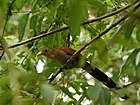
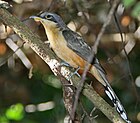
Order: Cuculiformes. Family: Cuculidae
The family Cuculidae includes cuckoos, roadrunners and anis. These birds are of variable size with slender bodies, long tails and strong legs. Unlike the cuckoo species of the Old World, North American cuckoos are not brood parasites. There are 138 species worldwide and 9 species which occur in Guatemala.
- Black-billed Cuckoo Coccyzus erythropthalmus
- Yellow-billed Cuckoo Coccyzus americanus
- Mangrove Cuckoo Coccyzus minor
- Squirrel Cuckoo Piaya cayana
- Groove-billed Ani Crotophaga sulcirostris
- Striped Cuckoo Tapera naevia
- Pheasant Cuckoo Dromococcyx phasianellus
- Lesser Ground-Cuckoo Morococcyx erythropygus
- Lesser Roadrunner Geococcyx velox
Barn owls

Order: Strigiformes. Family: Tytonidae
Barn owls are medium to large sized owls with large heads and characteristic heart-shaped faces. They have long strong legs with powerful talons. There are 16 species worldwide and 1 species which occurs in Guatemala.
- Barn Owl Tyto alba
Typical owls


Order: Strigiformes. Family: Strigidae
Typical owls are small to large solitary nocturnal birds of prey. They have large forward-facing eyes and ears, a hawk-like beak, and a conspicuous circle of feathers around each eye called a facial disk. There are 195 species worldwide and 22 species which occur in Guatemala.
- Flammulated Owl Otus flammeolus
- Western Screech-Owl Megascops kennicottii
- Pacific Screech-Owl Megascops cooperi
- Whiskered Screech-Owl Megascops trichopsis
- Bearded Screech-Owl Megascops barbarus
- Guatemalan Screech-Owl Megascops guatemalae
- Great Horned Owl Bubo virginianus
- Fulvous Owl Strix fulvescens
- Mottled Owl Ciccaba virgata
- Black-and-white Owl Ciccaba nigrolineata
- Crested Owl Lophostrix cristata
- Spectacled Owl Pulsatrix perspicillata
- Northern Pygmy-Owl Glaucidium californicum
- Mountain Pygmy-Owl Glaucidium gnoma
- Guatemalan Pygmy-Owl Glaucidium cobanense (E)
- Central American Pygmy-Owl Glaucidium griseiceps
- Ferruginous Pygmy-Owl Glaucidium brasilianum
- Burrowing Owl Athene cunicularia
- Unspotted Saw-whet Owl Aegolius ridgwayi
- Striped Owl Pseudoscops clamator
- Stygian Owl Asio stygius
- Short-eared Owl Asio flammeus (A)
Potoos

Order: Caprimulgiformes. Family: Nyctibiidae
The potoos (sometimes called Poor-Me-Ones) are large near passerine birds related to the nightjars and frogmouths. They are nocturnal insectivores which lack the bristles around the mouth found in the true nightjars. There are 5 species, all of which are from the South American tropical region, and 2 species which occur in Guatemala.
- Great Potoo Nyctibius grandis
- Northern Potoo Nyctibius jamaicensis
Nightjars

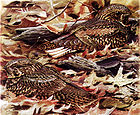
Order: Caprimulgiformes. Family: Caprimulgidae
Nightjars are medium-sized nocturnal birds with long wings, short legs and very short bills that usually nest on the ground. Most have small feet, of little use for walking, and long pointed wings. Their soft plumage is camouflaged to resemble bark or leaves. There are 86 species worldwide and 9 species which occur in Guatemala.
- Short-tailed Nighthawk Lurocalis semitorquatus
- Lesser Nighthawk Chordeiles acutipennis
- Common Nighthawk Chordeiles minor
- Pauraque Nyctidromus albicollis
- Yucatan Poorwill Nyctiphrynus yucatanicus
- Chuck-will's-widow Caprimulgus carolinensis
- Yucatan Nightjar Caprimulgus badius
- Buff-collared Nightjar Caprimulgus ridgwayi
- Whip-poor-will Caprimulgus vociferus
Swifts

Order: Apodiformes. Family: Apodidae
Swifts are small aerial birds, spending the majority of their lives flying. These birds have very short legs and never settle voluntarily on the ground, perching instead only on vertical surfaces. Many swifts have long swept-back wings that resemble a crescent or a boomerang. There are 98 species worldwide and 9 species which occur in Guatemala.
- Black Swift Cypseloides niger
- White-chinned Swift Cypseloides cryptus
- Chestnut-collared Swift Streptoprocne rutila
- White-collared Swift Streptoprocne zonaris
- Chimney Swift Chaetura pelagica
- Vaux's Swift Chaetura vauxi
- White-throated Swift Aeronautes saxatalis
- Great Swallow-tailed Swift Panyptila sanctihieronymi
- Lesser Swallow-tailed Swift Panyptila cayennensis
Hummingbirds

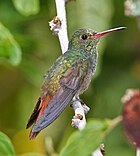
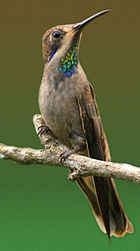

Order: Trochiliformes. Family: Trochilidae
Hummingbirds are small birds capable of hovering in mid-air due to the rapid flapping of their wings. They are the only birds that can fly backwards. There are 337 species worldwide and 39 species which occur in Guatemala.
- Band-tailed Barbthroat Threnetes ruckeri
- Western Long-tailed Hermit Phaethornis longirostris
- Stripe-throated Hermit Phaethornis striigularis
- Scaly-breasted Hummingbird Phaeochroa cuvierii
- Wedge-tailed Sabrewing Campylopterus curvipennis
- Rufous Sabrewing Campylopterus rufus
- Violet Sabrewing Campylopterus hemileucurus
- White-necked Jacobin Florisuga mellivora
- Brown Violet-ear Colibri delphinae
- Green Violet-ear Colibri thalassinus
- Green-breasted Mango Anthracothorax prevostii
- Emerald-chinned Hummingbird Abeillia abeillei
- Black-crested Coquette Lophornis helenae
- Canivet's Emerald Chlorostilbon canivetii
- Stripe-tailed Hummingbird Eupherusa eximia
- Violet-crowned Woodnymph Thalurania colombica
- Blue-throated Goldentail Hylocharis eliciae
- White-eared Hummingbird Hylocharis leucotis
- Rufous-tailed Hummingbird Amazilia tzacatl
- Buff-bellied Hummingbird Amazilia yucatanensis
- Cinnamon Hummingbird Amazilia rutila
- White-bellied Emerald Agyrtria candida
- Azure-crowned Hummingbird Agyrtria cyanocephala
- Green-fronted Hummingbird Agyrtria viridifrons
- Blue-tailed Hummingbird Saucerottia cyanura
- Berylline Hummingbird Saucerottia beryllina
- Amethyst-throated Hummingbird Lampornis amethystinus
- Green-throated Mountain-gem Lampornis viridipallens
- Garnet-throated Hummingbird Lamprolaima rhami
- Magnificent Hummingbird Eugenes fulgens
- Purple-crowned Fairy Heliothryx barroti
- Plain-capped Starthroat Heliomaster constantii
- Long-billed Starthroat Heliomaster longirostris
- Sparkling-tailed Hummingbird Tilmatura dupontii
- Slender Sheartail Doricha enicura
- Ruby-throated Hummingbird Archilochus colubris
- Wine-throated Hummingbird Atthis ellioti
- Broad-tailed Hummingbird Selasphorus platycercus
- Rufous Hummingbird Selasphorus rufus
Trogons and Quetzals
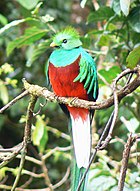
Order: Trogoniformes. Family: Trogonidae
The family Trogonidae includes trogons and quetzals. Found in tropical woodlands worldwide, they feed on insects and fruit, and their broad bills and weak legs reflect their diet and arboreal habits. Although their flight is fast, they are reluctant to fly any distance. Trogons have soft, often colourful, feathers with distinctive male and female plumage. There are 33 species worldwide and 7 species which occur in Guatemala.
- Black-headed Trogon Trogon melanocephalus
- Violaceous Trogon Trogon violaceus
- Mountain Trogon Trogon mexicanus
- Collared Trogon Trogon collaris
- Elegant Trogon Trogon elegans
- Slaty-tailed Trogon Trogon massena
- Resplendent Quetzal Pharomachrus mocinno
Kingfishers
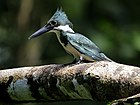
Order: Coraciiformes. Family: Alcedinidae
Kingfishers are medium-sized birds with large heads, long pointed bills, short legs, and stubby tails. There are 93 species worldwide and 5 species which occur in Guatemala.
- Belted Kingfisher Ceryle alcyon
- Ringed Kingfisher Ceryle torquatus
- Amazon Kingfisher Chloroceryle amazona
- Green Kingfisher Chloroceryle americana
- American Pygmy Kingfisher Chloroceryle aenea
Motmots
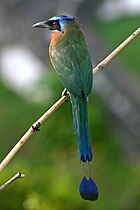
Order: Coraciiformes. Family: Momotidae
The motmots have colorful plumage and long, graduated tails, which they display by waggling back and forth. In most of the species, the barbs near the ends of the two longest (central) tail feathers are weak and fall off, leaving a length of bare shaft, and creating a racket-shaped tail. There are 10 species worldwide and 7 species which occur in Guatemala.
- Tody Motmot Hylomanes momotula
- Blue-throated Motmot Aspatha gularis
- Russet-crowned Motmot Momotus mexicanus
- Blue-crowned Motmot Momotus momota
- Keel-billed Motmot Electron carinatum
- Broad-billed Motmot Electron platyrhynchum
- Turquoise-browed Motmot Eumomota superciliosa
Jacamars
Order: Piciformes. Family: Galbulidae
The jacamars are near passerine birds from tropical South America, with a range that extends up to Mexico. They are glossy elegant birds with long bills and tails, which feed on insects caught on the wing. In appearance and behaviour they show resemblances to the Old World bee-eaters, although they are more closely related to woodpeckers. There are 18 species and 1 species that occur in Guatemala.
- Rufous-tailed Jacamar Galbula ruficauda
Puffbirds

Order: Piciformes. Family: Bucconidae
The puffbirds are related to the jacamars, and have the same range, but lack the iridescent colours of that family. They are mainly brown, rufous or grey, with large heads and flattened bills with a hooked tip. The loose abundant plumage and short tails makes them look stout and puffy, giving rise to the English common name of the family. There are 34 species and 2 species which occur in Guatemala.
- White-necked Puffbird Notharchus macrorhynchos
- White-whiskered Puffbird Malacoptila panamensis
Toucans

Order: Piciformes. Family: Ramphastidae
Toucans are near passerine birds from the neotropics. They are brightly marked and have enormous, colourful bills which in some species may amount to half their body length. There are 40 species worldwide and 3 species which occur in Guatemala.
- Collared Aracari Pteroglossus torquatus
- Keel-billed Toucan Ramphastos sulfuratus
- Emerald Toucanet Aulacorhynchus prasinus
Woodpeckers and allies

Order: Piciformes. Family: Picidae
Woodpeckers are small to medium sized birds with chisel like beaks, short legs, stiff tails and long tongues used for capturing insects. Some species have feet with two toes pointing forward, and two backward, while several species have only three toes. Many woodpeckers have the habit of tapping noisily on tree trunks with their beaks. There are 218 species worldwide and 13 species which occur in Guatemala.
- Olivaceous Piculet Picumnus olivaceus
- Acorn Woodpecker Melanerpes formicivorus
- Black-cheeked Woodpecker Melanerpes pucherani
- Golden-fronted Woodpecker Melanerpes aurifrons
- Yellow-bellied Sapsucker Sphyrapicus varius
- Ladder-backed Woodpecker Picoides scalaris
- Hairy Woodpecker Picoides villosus
- Smoky-brown Woodpecker Veniliornis fumigatus
- Golden-olive Woodpecker Piculus rubiginosus
- Northern Flicker Colaptes auratus
- Chestnut-colored Woodpecker Celeus castaneus
- Lineated Woodpecker Dryocopus lineatus
- Pale-billed Woodpecker Campephilus guatemalensis
Ovenbirds

Order: Passeriformes. Family: Furnariidae
Ovenbirds comprise a large family of small sub-oscine passerine bird species found in Central and South America. They are a diverse group of insectivores which gets its name from the elaborate "oven-like" clay nests built by some species, although others build stick nests or nest in tunnels or clefts in rock. There are 243 species worldwide and 8 species which occur in Guatemala.
- Rufous-breasted Spinetail Synallaxis erythrothorax
- Plain Xenops Xenops minutus
- Scaly-throated Foliage-gleaner Anabacerthia variegaticeps
- Buff-fronted Foliage-gleaner Philydor rufus
- Buff-throated Foliage-gleaner Automolus ochrolaemus
- Ruddy Foliage-gleaner Automolus rubiginosus
- Tawny-throated Leaftosser Sclerurus mexicanus
- Scaly-throated Leaftosser Sclerurus guatemalensis
Woodcreepers

Order: Passeriformes. Family: Dendrocolaptidae
The Dendrocolaptidae are brownish birds and maintain an upright vertical posture, supported by their stiff tail vanes. They feed mainly on insects taken from tree trunks. There are 57 species worldwide and 12 species which occur in Guatemala.
- Tawny-winged Woodcreeper Dendrocincla anabatina
- Ruddy Woodcreeper Dendrocincla homochroa
- Olivaceous Woodcreeper Sittasomus griseicapillus
- Wedge-billed Woodcreeper Glyphorynchus spirurus
- Strong-billed Woodcreeper Xiphocolaptes promeropirhynchus
- Northern Barred-Woodcreeper Dendrocolaptes sanctithomae
- Black-banded Woodcreeper Dendrocolaptes picumnus
- Cocoa Woodcreeper Xiphorhynchus susurrans
- Ivory-billed Woodcreeper Xiphorhynchus flavigaster
- Spotted Woodcreeper Xiphorhynchus erythropygius
- Streak-headed Woodcreeper Lepidocolaptes souleyetii
- Spot-crowned Woodcreeper Lepidocolaptes affinis
Typical antbirds


Order: Passeriformes. Family: Thamnophilidae
The antbirds are a large family of small passerine birds of subtropical and tropical Central and South America. They are forest birds, and tend to feed on insects at or near the ground. A sizable minority of them specialize in following columns of army ants to eat the small invertebrates that leave hiding to flee the ants.Many species lack bright colour; brown, black and white being the dominant tones. There are about 212 species worldwide and 9 species which occur in Guatemala.
- Great Antshrike Taraba major
- Barred Antshrike Thamnophilus doliatus
- Western Slaty-Antshrike Thamnophilus atrinucha
- Russet Antshrike Thamnistes anabatinus
- Plain Antvireo Dysithamnus mentalis
- Slaty Antwren Myrmotherula schisticolor
- Dot-winged Antwren Microrhopias quixensis
- Dusky Antbird Cercomacra tyrannina
- Bare-crowned Antbird Gymnocichla nudiceps
Antthrushes and Antpittas
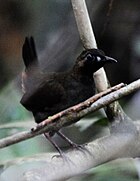
Order: Passeriformes. Family: Formicariidae
The ground antbirds are a family comprising the antthrushes and antpittas. Antthrushes resemble small rails while antpittas resemble the true pittas with longish strong legs, very short tails and stout bills. There are about 63 species worldwide and 2 species which occur in Guatemala.
- Mexican Antthrush Formicarius moniliger
- Scaled Antpitta Grallaria guatimalensis
Cotingas
Order: Passeriformes. Family: Cotingidae
The cotingas are birds of forests or forest edges of tropical South America. Comparatively little is known about this diverse group, although all have broad bills with hooked tips, rounded wings, and strong legs. The males of many of the species are brightly coloured, or decorated with plumes or wattles. There are 71 species worldwide and 2 species which occur in Guatemala
- Rufous Piha Lipaugus unirufus
- Lovely Cotinga Cotinga amabilis
Manakins

Order: Passeriformes. Family: Pipridae
The manakins are a family bird species of subtropical and tropical mainland Central and South America, and Trinidad and Tobago. They are compact forest birds, the males typically being brightly coloured, although the females of most species are duller and usually green-plumaged. Manakins feed on small fruits, berries and insects. There are 57 species worldwide and 5 species which occur in Guatemala.
- White-collared Manakin Manacus candei
- Long-tailed Manakin Chiroxiphia linearis
- Red-capped Manakin Pipra mentalis
- Gray-headed Piprites Piprites griseiceps
- Thrush-like Schiffornis Schiffornis turdinus
Tyrant flycatchers
Order: Passeriformes. Family: Tyrannidae
Tyrant flycatchers are passerine birds which occur throughout North and South America. They superficially resemble the Old World flycatchers, but are more robust with stronger bills. They do not have the sophisticated vocal capabilities of the songbirds. Most, but not all, have plain colouring. As the name implies, most are insectivorous. There are 429 species worldwide, all found only in the Americas and 69 species which occur in Guatemala.

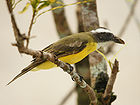




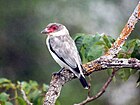

- Yellow-bellied Tyrannulet Ornithion semiflavum
- Northern Beardless-Tyrannulet Camptostoma imberbe
- Greenish Elaenia Myiopagis viridicata
- Yellow-bellied Elaenia Elaenia flavogaster
- Mountain Elaenia Elaenia frantzii
- Ochre-bellied Flycatcher Mionectes oleagineus
- Sepia-capped Flycatcher Leptopogon amaurocephalus
- Paltry Tyrannulet Zimmerius vilissimus
- Northern Bentbill Oncostoma cinereigulare
- Slate-headed Tody-Tyrant Poecilotriccus sylvia
- Common Tody-Flycatcher Todirostrum cinereum
- Eye-ringed Flatbill Rhynchocyclus brevirostris
- Yellow-olive Flycatcher Tolmomyias sulphurescens
- Stub-tailed Spadebill Platyrinchus cancrominus
- White-throated Spadebill Platyrinchus mystaceus
- Northern Royal-Flycatcher Onychorhynchus mexicanus
- Ruddy-tailed Flycatcher Terenotriccus erythrurus
- Sulphur-rumped Flycatcher Myiobius sulphureipygius
- Belted Flycatcher Xenotriccus callizonus
- Tufted Flycatcher Mitrephanes phaeocercus
- Olive-sided Flycatcher Contopus cooperi
- Greater Pewee Contopus pertinax
- Western Wood-Pewee Contopus sordidulus
- Eastern Wood-Pewee Contopus virens
- Tropical Pewee Contopus cinereus
- Yellow-bellied Flycatcher Empidonax flaviventris
- Acadian Flycatcher Empidonax virescens
- Alder Flycatcher Empidonax alnorum
- Willow Flycatcher Empidonax traillii
- White-throated Flycatcher Empidonax albigularis
- Least Flycatcher Empidonax minimus
- Hammond's Flycatcher Empidonax hammondii
- Dusky Flycatcher Empidonax oberholseri (A)
- Pine Flycatcher Empidonax affinis
- Pacific-slope Flycatcher Empidonax difficilis
- Cordilleran Flycatcher Empidonax occidentalis
- Yellowish Flycatcher Empidonax flavescens
- Buff-breasted Flycatcher Empidonax fulvifrons
- Black Phoebe Sayornis nigricans
- Vermilion Flycatcher Pyrocephalus rubinus
- Bright-rumped Attila Attila spadiceus
- Speckled Mourner Laniocera rufescens
- Rufous Mourner Rhytipterna holerythra
- Yucatan Flycatcher Myiarchus yucatanensis
- Dusky-capped Flycatcher Myiarchus tuberculifer
- Ash-throated Flycatcher Myiarchus cinerascens
- Nutting's Flycatcher Myiarchus nuttingi
- Great Crested Flycatcher Myiarchus crinitus
- Brown-crested Flycatcher Myiarchus tyrannulus
- Great Kiskadee Pitangus sulphuratus
- Boat-billed Flycatcher Megarynchus pitangua
- Social Flycatcher Myiozetetes similis
- Streaked Flycatcher Myiodynastes maculatus
- Sulphur-bellied Flycatcher Myiodynastes luteiventris
- Piratic Flycatcher Legatus leucophaius
- Tropical Kingbird Tyrannus melancholicus
- Couch's Kingbird Tyrannus couchii
- Cassin's Kingbird Tyrannus vociferans
- Thick-billed Kingbird Tyrannus crassirostris (A)
- Western Kingbird Tyrannus verticalis
- Eastern Kingbird Tyrannus tyrannus
- Scissor-tailed Flycatcher Tyrannus forficatus
- Fork-tailed Flycatcher Tyrannus savana
- Cinnamon Becard Pachyramphus cinnamomeus
- White-winged Becard Pachyramphus polychopterus
- Gray-collared Becard Pachyramphus major
- Rose-throated Becard Pachyramphus aglaiae
- Masked Tityra Tityra semifasciata
- Black-crowned Tityra Tityra inquisitor
Swallows and martins
Order: Passeriformes. Family: Hirundinidae
The Hirundinidae family is a group of passerines characterized by their adaptation to aerial feeding. Their adaptations include a slender streamlined body, long pointed wings and short bills with wide gape. The feet are designed for perching rather than walking, and the front toes are partially joined at the base. There are 75 species worldwide and 14 species which occur in Guatemala.

- Purple Martin Progne subis
- Cuban Martin Progne cryptoleuca (A)
- Caribbean Martin Progne dominicensis
- Sinaloa Martin Progne sinaloae
- Gray-breasted Martin Progne chalybea
- Tree Swallow Tachycineta bicolor
- Mangrove Swallow Tachycineta albilinea
- Violet-green Swallow Tachycineta thalassina
- Black-capped Swallow Notiochelidon pileata
- Northern Rough-winged Swallow Stelgidopteryx serripennis
- Southern Rough-winged Swallow Stelgidopteryx ruficollis
- Bank Swallow Riparia riparia
- Cliff Swallow Petrochelidon pyrrhonota
- Barn Swallow Hirundo rustica
Wagtails and pipits
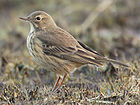
Order: Passeriformes. Family: Motacillidae
The Motacillidae are a family of small passerine birds with medium to long tails. They include the wagtails, longclaws and pipits. They are slender, ground feeding insectivores of open country. There are 54 species worldwide and 1 species which occurs in Guatemala.
- American Pipit Anthus rubescens
Kinglets

Order: Passeriformes. Family: Regulidae
The kinglets or crests are a small group of birds often included in the Old World warblers, but frequently given family status because they also resemble the titmice. There are 7 species worldwide and 2 species which occur in Guatemala.
- Golden-crowned Kinglet Regulus satrapa
- Ruby-crowned Kinglet Regulus calendula
Silky-flycatchers
Order: Passeriformes. Family: Ptilogonatidae
The silky-flycatchers are a small family of passerine birds which occur mainly in Central America, although the range of one species. They are related to waxwings, and like that group have a soft silky plumage, usually grey or pale yellow in colour. They have small crests. There are 4 species worldwide and1 species which occurs in Guatemala.
- Gray Silky-flycatcher Ptilogonys cinereus
Waxwings

Order: Passeriformes. Family: Bombycillidae
The waxwings are a group of passerine birds characterized by soft silky plumage and unique red tips to some of the wing feathers. In the Bohemian and Cedar Waxwings, these tips look like sealing wax, and give the group its name. These are arboreal birds of northern forests. They live on insects in summer and berries in winter. There are 3 species worldwide and1 species which occurs in Guatemala.
- Cedar Waxwing Bombycilla cedrorum
Dippers

Order: Passeriformes. Family: Cinclidae
Dippers are a group of perching birds whose habitat includes aquatic environments in the Americas, Europe, and Asia. They are named for their bobbing or dipping movements. There are 5 species worldwide and 1 species which occurs in Guatemala.
- American Dipper Cinclus mexicanus
Wrens

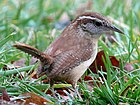
Order: Passeriformes. Family: Troglodytidae
The wrens are mainly small and inconspicuous except for their loud songs. These birds have short wings and a thin down-turned bill. Several species often hold their tails upright. All are insectivorous. There are 80 species worldwide (of which all but one are New World species) and 15 species which occur in Guatemala.
- Band-backed Wren Campylorhynchus zonatus
- Rufous-naped Wren Campylorhynchus rufinucha
- Rock Wren Salpinctes obsoletus
- Spot-breasted Wren Thryothorus maculipectus
- Banded Wren Thryothorus pleurostictus
- Carolina Wren Thryothorus ludovicianus
- Rufous-and-white Wren Thryothorus rufalbus
- Plain Wren Thryothorus modestus
- House Wren Troglodytes aedon
- Rufous-browed Wren Troglodytes rufociliatus
- Sedge Wren Cistothorus platensis
- White-bellied Wren Uropsila leucogastra
- White-breasted Wood-Wren Henicorhina leucosticta
- Gray-breasted Wood-Wren Henicorhina leucophrys
- Nightingale Wren Microcerculus philomela
Mockingbirds and Thrashers

Order: Passeriformes. Family: Mimidae
The mimids are a family of passerine birds that includes thrashers, mockingbirds, tremblers, and the New World catbirds. These birds are notable for their vocalizations, especially their ability to mimic a wide variety of birds and other sounds heard outdoors. Their colouring tends towards dull greys and browns . There are 35 species worldwide and 4 species which occur in Guatemala.
- Gray Catbird Dumetella carolinensis
- Black Catbird Melanoptila glabrirostris
- Tropical Mockingbird Mimus gilvus
- Blue-and-white Mockingbird Melanotis hypoleucus
Thrushes and allies
Order: Passeriformes. Family: Turdidae


The thrushes are a group of passerine birds that occur mainly in the Old World. They are plump, soft plumaged, small to medium-sized insectivores or sometimes omnivores, often feeding on the ground. Many have attractive songs. There are 335 species worldwide and 18 species which occur in Guatemala.
- Eastern Bluebird Sialia sialis
- Brown-backed Solitaire Myadestes occidentalis
- Slate-colored Solitaire Myadestes unicolor
- Orange-billed Nightingale-Thrush Catharus aurantiirostris
- Ruddy-capped Nightingale-Thrush Catharus frantzii
- Black-headed Nightingale-Thrush Catharus mexicanus
- Spotted Nightingale-Thrush Catharus dryas
- Veery Catharus fuscescens
- Gray-cheeked Thrush Catharus minimus
- Swainson's Thrush Catharus ustulatus
- Hermit Thrush Catharus guttatus
- Wood Thrush Hylocichla mustelina
- Black Robin Turdus infuscatus
- Mountain Robin Turdus plebejus
- Clay-colored Robin Turdus grayi
- White-throated Thrush Turdus assimilis
- Rufous-collared Robin Turdus rufitorques
- American Robin Turdus migratorius
Gnatcatchers
Order: Passeriformes. Family: Polioptilidae
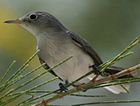
These dainty birds resemble Old World warblers in their build and habits, moving restlessly through the foliage seeking insects. The gnatcatchers and gnatwrens are mainly soft bluish grey in colour, and have the typical insectivore's long sharp bill. They are birds of fairly open woodland or scrub, and nest in bushes or trees. There are 15 species worldwide and 4 species which occur in Guatemala.
- Long-billed Gnatwren Ramphocaenus melanurus
- Blue-gray Gnatcatcher Polioptila caerulea
- White-lored Gnatcatcher Polioptila albiloris
- Tropical Gnatcatcher Polioptila plumbea
Long-tailed tits

Order: Passeriformes. Family: Aegithalidae
Long-tailed tits are a group of small passerine birds with medium to long tails. They make woven bag nests in trees. Most eat a mixed diet that includes insects. There are 9 species worldwide and1 species which occurs in Guatemala.
- Bushtit Psaltriparus minimus
Treecreepers
Order: Passeriformes. Family: Certhiidae
Treecreepers are small woodland birds, brown above and white below. They have thin pointed down-curved bills, which they use to extricate insects from bark. They have stiff tail feathers, like woodpeckers, which they use to support themselves on vertical trees. There are 6 species worldwide and1 species which occurs in Guatemala.
- Brown Creeper Certhia americana
Crows, jays, ravens and magpies
Order: Passeriformes. Family: Corvidae


The Corvidae family includes crows, ravens, jays, choughs, magpies, treepies, nutcrackers, and ground jays. Corvids are above average in size for the bird order Passeriformes. Some of the larger species show high levels of learning behavior. There are 120 species worldwide and 10 species which occur in Guatemala.
- Steller's Jay Cyanocitta stelleri
- White-throated Magpie-Jay Calocitta formosa
- Green Jay Cyanocorax yncas
- Brown Jay Cyanocorax morio
- Bushy-crested Jay Cyanocorax melanocyaneus
- Yucatan Jay Cyanocorax yucatanicus
- Azure-hooded Jay Cyanolyca cucullata
- Black-throated Jay Cyanolyca pumilo
- Unicolored Jay Aphelocoma unicolor
- Common Raven Corvus corax
Vireos
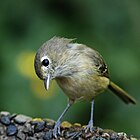


Order: Passeriformes. Family: Vireonidae
The vireos are a group of small to medium sized passerine birds restricted to the New World. They are typically greenish in colour and resemble wood warblers apart from their heavier bills. There are 52 species worldwide and 20 species which occur in Guatemala.
- White-eyed Vireo Vireo griseus
- Mangrove Vireo Vireo pallens
- Bell's Vireo Vireo bellii
- Yellow-throated Vireo Vireo flavifrons
- Plumbeous Vireo Vireo plumbeus
- Cassin's Vireo Vireo cassinii
- Blue-headed Vireo Vireo solitarius
- Hutton's Vireo Vireo huttoni
- Warbling Vireo Vireo gilvus
- Brown-capped Vireo Vireo leucophrys
- Philadelphia Vireo Vireo philadelphicus
- Red-eyed Vireo Vireo olivaceus
- Yellow-green Vireo Vireo flavoviridis
- Black-whiskered Vireo Vireo altiloquus
- Yucatan Vireo Vireo magister
- Tawny-crowned Greenlet Hylophilus ochraceiceps
- Lesser Greenlet Hylophilus decurtatus
- Chestnut-sided Shrike-Vireo Vireolanius melitophrys
- Green Shrike-Vireo Vireolanius pulchellus
- Rufous-browed Peppershrike Cyclarhis gujanensis
Olive Warbler

Order: Passeriformes. Family: Peucedramidae
The Olive Warbler is a small passerine bird, the only member of the family Peucedramidae. It is a long-winged bird with a grey body and some olive-green on the wings and two white wing bars. The male's head and breast are orange, the female's yellow.
- Olive Warbler Peucedramus taeniatus
New World warblers
Order: Passeriformes. Family: Parulidae







The New World warblers are a group of small, often colourful, passerine birds restricted to the New World. Most are arboreal, but some are terrestrial. Most members of this family are insectivores. There are 119 species worldwide and 52 species which occur in Guatemala.
- Blue-winged Warbler Vermivora pinus
- Golden-winged Warbler Vermivora chrysoptera
- Tennessee Warbler Vermivora peregrina
- Orange-crowned Warbler Vermivora celata
- Nashville Warbler Vermivora ruficapilla
- Virginia's Warbler Vermivora virginiae
- Crescent-chested Warbler Parula superciliosa
- Northern Parula Parula americana
- Tropical Parula Parula pitiayumi
- Yellow Warbler Dendroica petechia
- Chestnut-sided Warbler Dendroica pensylvanica
- Magnolia Warbler Dendroica magnolia
- Cape May Warbler Dendroica tigrina
- Black-throated Blue Warbler Dendroica caerulescens
- Yellow-rumped Warbler Dendroica coronata
- Black-throated Gray Warbler Dendroica nigrescens
- Golden-cheeked Warbler Dendroica chrysoparia
- Black-throated Green Warbler Dendroica virens
- Townsend's Warbler Dendroica townsendi
- Hermit Warbler Dendroica occidentalis
- Blackburnian Warbler Dendroica fusca
- Yellow-throated Warbler Dendroica dominica
- Grace's Warbler Dendroica graciae
- Prairie Warbler Dendroica discolor
- Bay-breasted Warbler Dendroica castanea
- Cerulean Warbler Dendroica cerulea
- Black-and-white Warbler Mniotilta varia
- American Redstart Setophaga ruticilla
- Prothonotary Warbler Protonotaria citrea
- Worm-eating Warbler Helmitheros vermivorus
- Swainson's Warbler Limnothlypis swainsonii
- Ovenbird Seiurus aurocapilla
- Northern Waterthrush Seiurus noveboracensis
- Louisiana Waterthrush Seiurus motacilla
- Kentucky Warbler Oporornis formosus
- Mourning Warbler Oporornis philadelphia
- MacGillivray's Warbler Oporornis tolmiei
- Common Yellowthroat Geothlypis trichas
- Gray-crowned Yellowthroat Geothlypis poliocephala
- Hooded Warbler Wilsonia citrina
- Wilson's Warbler Wilsonia pusilla
- Canada Warbler Wilsonia canadensis
- Red-faced Warbler Cardellina rubrifrons
- Pink-headed Warbler Ergaticus versicolor
- Painted Redstart Myioborus pictus
- Slate-throated Redstart Myioborus miniatus
- Fan-tailed Warbler Euthlypis lachrymosa
- Golden-crowned Warbler Basileuterus culicivorus
- Rufous-capped Warbler Basileuterus rufifrons
- Golden-browed Warbler Basileuterus belli
- Yellow-breasted Chat Icteria virens
- Gray-throated Chat Granatellus sallaei
Bananaquit
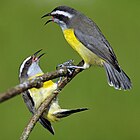
Order: Passeriformes. Family: Coerebidae
The Bananaquit is a small passerine bird. It has a slender, curved bill, adapted to taking nectar from flowers and is the only member of the genus Coereba (Vieillot, 1809) and is normally placed within the family Coerebidae, although there is uncertainty whether that placement is correct.
- Bananaquit Coereba flaveola
Tanagers



Order: Passeriformes. Family: Thraupidae
The tanagers are a large group of small to medium-sized passerine birds restricted to the New World, mainly in the tropics. Many species are brightly coloured. They are seed eaters, but their preference tends towards fruit and nectar. Most have short, rounded wings. There are 256 species worldwide and 28 species which occur in Guatemala.
- Common Bush-Tanager Chlorospingus ophthalmicus
- Gray-headed Tanager Eucometis penicillata
- Black-throated Shrike-Tanager Lanio aurantius
- Red-crowned Ant-Tanager Habia rubica
- Red-throated Ant-Tanager Habia fuscicauda
- Rose-throated Tanager Piranga roseogularis
- Hepatic Tanager Piranga flava
- Scarlet Tanager Piranga olivacea
- Summer Tanager Piranga rubra
- Western Tanager Piranga ludoviciana
- Flame-colored Tanager Piranga bidentata
- White-winged Tanager Piranga leucoptera
- Crimson-collared Tanager Ramphocelus sanguinolentus
- Passerini's Tanager Ramphocelus passerinii
- Blue-gray Tanager Thraupis episcopus
- Yellow-winged Tanager Thraupis abbas
- Scrub Euphonia Euphonia affinis
- Yellow-throated Euphonia Euphonia hirundinacea
- Elegant Euphonia Euphonia elegantissima
- Olive-backed Euphonia Euphonia gouldi
- White-vented Euphonia Euphonia minuta
- Blue-crowned Chlorophonia Chlorophonia occipitalis
- Azure-rumped Tanager Tangara cabanisi
- Rufous-winged Tanager Tangara lavinia
- Golden-hooded Tanager Tangara larvata
- Green Honeycreeper Chlorophanes spiza
- Shining Honeycreeper Cyanerpes lucidus
- Red-legged Honeycreeper Cyanerpes cyaneus
Buntings, sparrows, seedeaters and allies
Order: Passeriformes. Family: Emberizidae




The emberizids are a large family of passerine birds. They are seed-eating birds with a distinctively shaped bill. In Europe, most species are named as buntings. In North America, most of the species in this family are known as Sparrows, but these birds are not closely related to the Old World sparrows which are in the family Passeridae. Many emberizid species have distinctive head patterns. There are species 275 worldwide and 32 species which occur in Guatemala.
- Blue-black Grassquit Volatinia jacarina
- Slate-colored Seedeater Sporophila schistacea
- Variable Seedeater Sporophila corvina
- White-collared Seedeater Sporophila torqueola
- Ruddy-breasted Seedeater Sporophila minuta
- Thick-billed Seed-Finch Oryzoborus funereus
- Blue Seedeater Amaurospiza concolor
- Yellow-faced Grassquit Tiaris olivacea
- Slaty Finch Haplospiza rustica
- Cinnamon-bellied Flowerpiercer Diglossa baritula
- Grassland Yellow-Finch Sicalis luteola
- White-naped Brush-Finch Atlapetes albinucha
- Chestnut-capped Brush-Finch Buarremon brunneinucha
- Orange-billed Sparrow Arremon aurantiirostris
- Olive Sparrow Arremonops rufivirgatus
- Green-backed Sparrow Arremonops chloronotus
- Prevost's Ground-Sparrow Melozone biarcuatum
- White-eared Ground-Sparrow Melozone leucotis
- Eastern Towhee Pipilo erythrophthalmus
- Spotted Towhee Pipilo maculatus
- Stripe-headed Sparrow Aimophila ruficauda
- Botteri's Sparrow Aimophila botterii
- Rusty Sparrow Aimophila rufescens
- Chipping Sparrow Spizella passerina
- Clay-colored Sparrow Spizella pallida (A)
- Vesper Sparrow Pooecetes gramineus (A)
- Lark Sparrow Chondestes grammacus (A)
- Savannah Sparrow Passerculus sandwichensis
- Grasshopper Sparrow Ammodramus savannarum
- Lincoln's Sparrow Melospiza lincolnii
- Rufous-collared Sparrow Zonotrichia capensis
- Yellow-eyed Junco Junco phaeonotus
Saltators, Cardinals and allies


Order: Passeriformes. Family: Cardinalidae
The cardinals are a family of passerine birds that are robust, seed-eating birds, with strong bills. They are typically associated with open woodland. The sexes usually have distinct plumages. There are 43 species worldwide and 14 species which occur in Guatemala.
- Grayish Saltator Saltator coerulescens
- Buff-throated Saltator Saltator maximus
- Black-headed Saltator Saltator atriceps
- Black-faced Grosbeak Caryothraustes poliogaster
- Northern Cardinal Cardinalis cardinalis
- Yellow Grosbeak Pheucticus chrysopeplus
- Rose-breasted Grosbeak Pheucticus ludovicianus
- Blue Bunting Cyanocompsa parellina
- Blue-black Grosbeak Cyanocompsa cyanoides
- Blue Grosbeak Passerina caerulea
- Indigo Bunting Passerina cyanea
- Varied Bunting Passerina versicolor
- Painted Bunting Passerina ciris
- Dickcissel Spiza americana
Troupials and allies

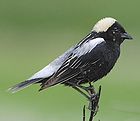

Order: Passeriformes. Family: Icteridae
The icterids are a group of small to medium, often colourful, passerine birds restricted to the New World and include the grackles, New World blackbirds, and New World orioles. Most species have black as the predominant plumage colour, often enlivened by yellow, orange or red. There are 98 species worldwide and 24 species which occur in Guatemala.
- Bobolink Dolichonyx oryzivorus
- Red-winged Blackbird Agelaius phoeniceus
- Eastern Meadowlark Sturnella magna
- Melodious Blackbird Dives dives
- Brewer's Blackbird Euphagus cyanocephalus (A)
- Great-tailed Grackle Quiscalus mexicanus
- Bronzed Cowbird Molothrus aeneus
- Giant Cowbird Molothrus oryzivorus
- Yellow-backed Oriole Icterus chrysater
- Yellow-tailed Oriole Icterus mesomelas
- Spot-breasted Oriole Icterus pectoralis
- Altamira Oriole Icterus gularis
- Streak-backed Oriole Icterus pustulatus
- Baltimore Oriole Icterus galbula
- Bullock's Oriole Icterus bullockii
- Orchard Oriole Icterus spurius
- Black-cowled Oriole Icterus prosthemelas
- Black-vented Oriole Icterus wagleri
- Audubon's Oriole Icterus graduacauda
- Bar-winged Oriole Icterus maculialatus
- Yellow-billed Cacique Amblycercus holosericeus
- Yellow-winged Cacique Cacicus melanicterus
- Chestnut-headed Oropendola Psarocolius wagleri
- Montezuma Oropendola Gymnostinops montezuma
Siskins, crossbills and allies


Order: Passeriformes. Family: Fringillidae
Finches are seed-eating passerine birds, that are small to moderately large and have a strong beak, usually conical and in some species very large. All have 12 tail feathers and 9 primaries. These birds have a bouncing flight with alternating bouts of flapping and gliding on closed wings, and most sing well. There are 137 species worldwide and 6 species which occur in Guatemala.
- Red Crossbill Loxia curvirostra
- Pine Siskin Carduelis pinus
- Black-capped Siskin Carduelis atriceps
- Black-headed Siskin Carduelis notata
- Lesser Goldfinch Carduelis psaltria
- Hooded Grosbeak Coccothraustes abeillei
Sparrows

Order: Passeriformes. Family: Passeridae
Sparrows are small passerine birds. In general, sparrows tend to be small, plump, brown or grey birds with short tails and short powerful beaks. Sparrows are seed-eaters, and they also consume small insects. There are 35 species worldwide and1 species which occurs in Guatemala.
- House Sparrow Passer domesticus (I)
See also
References
- Lepage, Denis. "Checklist of birds of Guatemala". Bird Checklists of the World. Avibase. Retrieved 26 April 2007.
{{cite web}}: Cite has empty unknown parameter:|coauthors=(help) - Clements, James F. (2000). Birds of the World: a Checklist. Cornell University Press. p. 880. ISBN 0-934797-16-1.
External links
- Birds of Guatemala Birdlist, multi-lingual website by country with standardized codes for abundance and seasonal presence.
